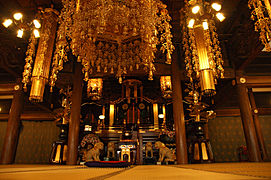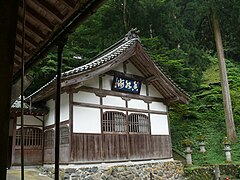Eihei-ji
Eihei-ji ( Japanese 永平 寺 ; Chinese 永平 寺 , Pinyin Yǒngpíng Sì , W.-G. Yung-p'ing Ssu ; German for "Temple of Eternal Peace") is a Buddhist monastery in Japan. It is one of the two main monasteries in the Sōtō-Zen line and was founded in 1243 by Dōgen in what was then the province of Echizen , today's Fukui Prefecture . The construction of the first plant was completed in 1244 and operated under the name Daibutsu-ji ( 大 仏 寺 ; German about "Temple of the Great Buddha"). In 1246 the complex was renamed Eihei-ji, which is also the name of the community ( Eiheiji (Fukui) ) in whose area the temple is currently located.
history
At the time of the founder of the monastery, it was assumed that Buddhism in the Yongping era ( 永平 , Yǒngpíng , Yung-p'ing ) was imported to China during the time of the Han dynasty . Master Dōgen wanted to express that, in contrast to the schools that had long been established in Japan, such as the Tendai School or Shingon School, he would now establish true Buddhism in Japan.
The location, which is far away from the centers of Japan to this day, was intended to serve as a shield against the increasing hostility from the Buddhist Tendai school. However, the hidden location also ensured that the Eihei-ji fell into oblivion over the years until it was completely destroyed in succession disputes in 1473. It was not until the late 16th century that a return to the Japanese founder of the Sōtō School and thus to the temple he founded, and the temple was completely rebuilt.
The attachment
The temple complex ( 七 堂 伽藍 , shichidō garan) located on the mountain slope is based on the Zen tradition . So we find (1) the main gate (1), the Buddha hall (2), the prayer hall (3), the meditation hall (4), the dining room (5), the bathroom (6) and the toilet (7). The buildings in detail:
- The main gate ( 山門 , Sammon), two-story, dates from 1749 and is the oldest surviving building. The four Kings of Heaven ( 四 天王 , Shitennō) are placed on the inside . The 500 rakan ( 羅漢 ) are venerated on the upper floor .
- The Buddha Hall ( 仏 殿 , Butsuden) is the center of the complex. Shakamuni are set up for the present, Amida on the left for the past and Miroku on the right for the future. The current hall was built in 1902.
- A Kannon is set up in the prayer hall ( 法堂 , Hattō). The current hall dates from 1843 and is 18 ken wide and 14 ken deep.
- The monk's hall ( 僧堂 , Sōdō) is also called Zen meditation hall ( 座 禅堂 , zazendō) or cloud hall ( 雲堂 , undō ). Monju Bosatu is worshiped there. The current hall dates from 1902 and is built in the style of the Southern Song . Their dimensions (width × depth) are 14 × 11 ken.
- The refectory ( 大 庫 院 , Daikuin) was built in 1930. It has a basement and three floors above ground. Only vegetarian food is served. The total area of the rooms is 750 Tsubo = 2250 m².
- The bath ( 浴室 , Yokushitsu) is one of the three places where no one speaks.
- The toilet ( 東 司 , Tōsu) is another place where no one speaks. (The third place is the Sōdō).
Other buildings of general interest include:
- The bell tower ( 鐘楼 , Shōrō) was rebuilt in the style of the Kamakura period in 1963. The big bell ( 大梵 鐘 , Ōbonshō) is rung four times a day. It has an opening of 1.5 m, a height of 3 m and weighs tons.
- Memorial Hall for the Abbots ( 承 陽 殿 , Jōyōden)
- Guest and practice hall for lay people ( 傘 松 閣 , Sanshōkaku)
- Memorial hall for lay people ( 祠堂 殿 , Shidōden)
- Reliquary Hall ( 舎 利 殿 , Shariden)
- Zen hall ( 禅堂 , Zendō)
- Great Devotional Hall ( 大 講堂 , Daikōdō)
- Middle Sparrow Gate ( 中 雀 門 , Chūjaku-mon) is the small gate between Sammon and Butsuden. It dates from 1852.
- "Gate in the Chinese style" ( 唐門 , Kara-mon), also called "Honor gate for imperial messengers" ( 勅使 門 , Chokushi-mon).
Image selection
Remarks
- ↑ The other is the Sōji-ji ( 總 持 寺 ) .
- ↑ Here Ken is the distance between two pillars. Since this decreases slightly from the center outwards, it is not 1.818 m continuously.
literature
- Eiheiji (Ed.): Sōtōshū daihonzan Eiheiji. 18 pp.
- Kaoru Nonomura: Eat Sleep Sit: My Year at Japan's Most Rigorous Zen Temple
Web links
- Official website - Japanese and English
- "THE EIHEI-JI" 永平 寺 曹洞宗 大本 山 永平 寺 (TokuunZenshoKoji) You Tube
Coordinates: 36 ° 3 ′ 22 ″ N , 136 ° 21 ′ 20 ″ E





